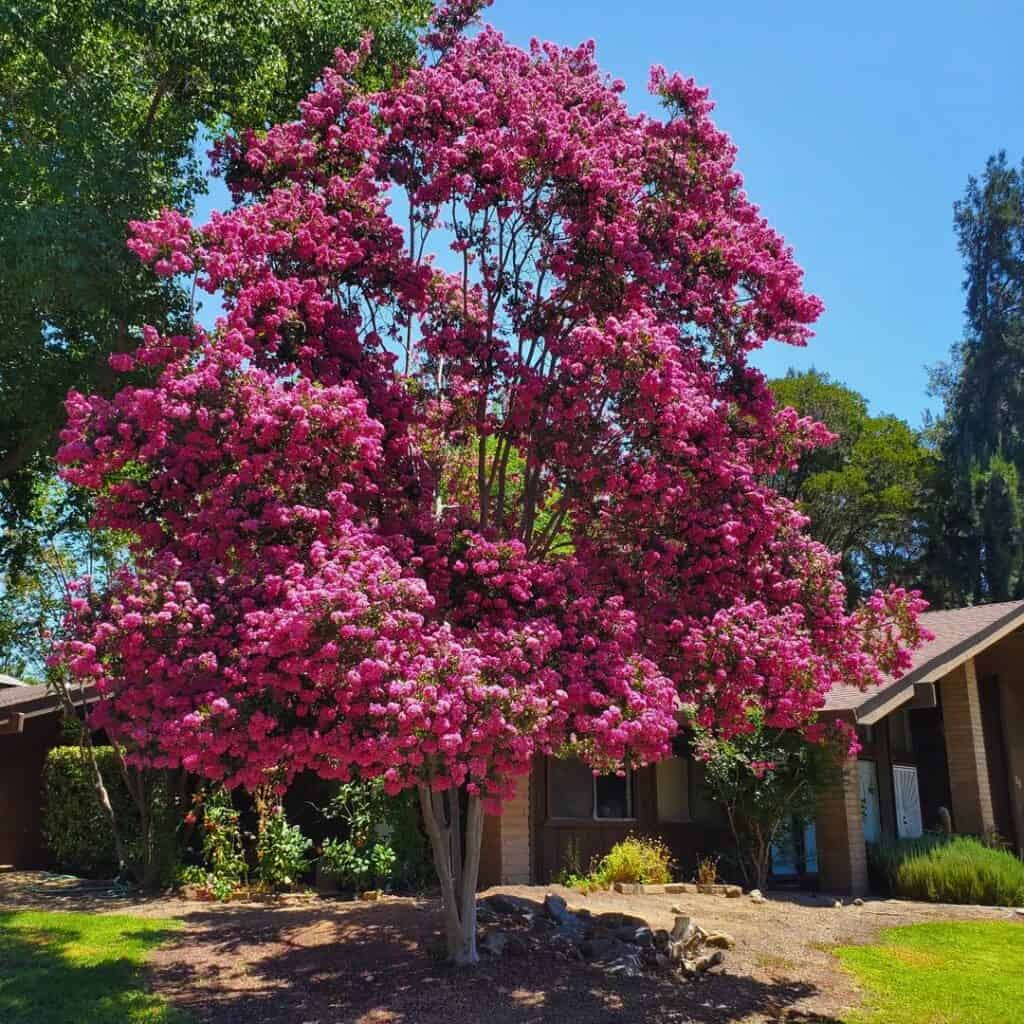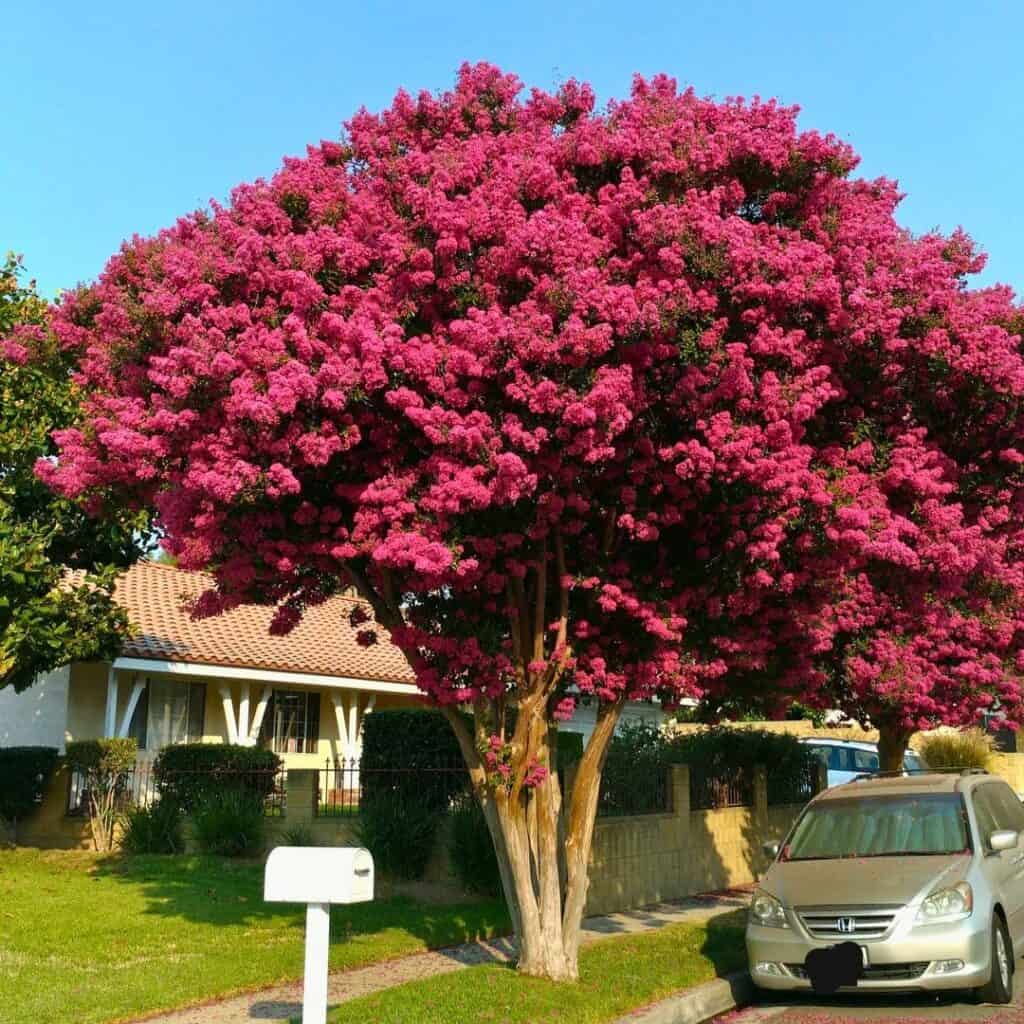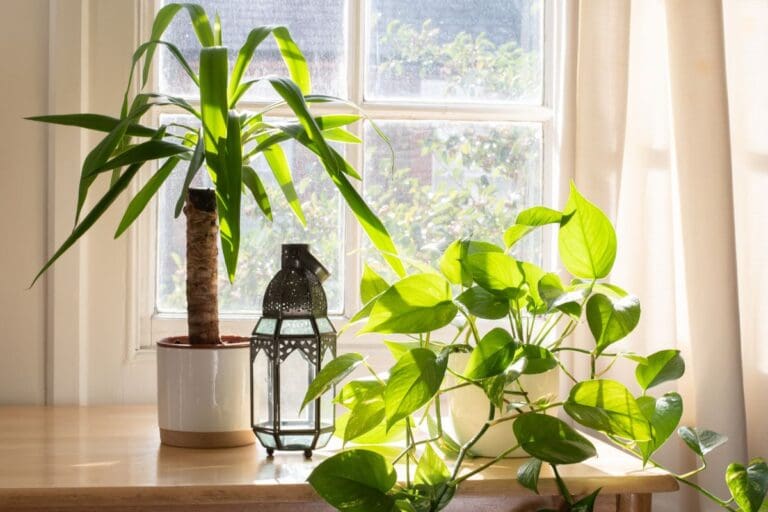Grow Stunning Crape Myrtles With These 7 Simple Tips
I just love how crape myrtles can instantly brighten up a yard with their bursts of color and that gorgeous, smooth bark.
If you give them the right care, they’re not really fussy, and you’ll get a showy tree that brings color year after year.
Let’s talk about a few straightforward things you can do to help your crape myrtles look their best.
Picking the right spot, pruning at the right time, and watering the right way—these steps matter way more than you might think.
Please note: Simplify Plants is reader-supported. As an Amazon Associate, I earn from qualifying purchases made by our readers with no extra cost added to you all! Some links in the post are affiliate links and I get a commission from purchases made through links in the post.
1) Choose a sunny spot with at least 6 hours of direct sunlight

First off, I always go for the sunniest spot in my yard when I’m planting crape myrtles. They really do love the warmth and need at least 6 hours of direct sunlight a day.
If they don’t get enough sun, they get kind of leggy and the blooms just aren’t as impressive. I’ve noticed the colors pop so much more when they’re in full sun, and the flowers seem to stick around longer.
Sunlight also keeps the plant stronger and helps it fight off disease. If you plant them in shade, the branches stretch awkwardly and the blooms are a bit of a letdown.
I like to pay attention to how the light moves through my yard during the day. Sometimes a spot looks sunny in the morning but gets shaded later, so I double-check before digging.
If you’re in a cooler climate, a south-facing spot is ideal for soaking up warmth. In really hot places, I sometimes give them a bit of afternoon shade just to keep the blooms from getting fried.
Good sun also dries the soil out between waterings, which is a plus. Honestly, I find crape myrtles in sunny spots need less fussing over and just look better.
I always try to avoid planting them near big trees or buildings that throw a lot of shade. A clear, open area is the way to go.
Strong sunlight equals strong blooms. That’s my go-to rule for crape myrtles.
2) Plant in well-draining soil enriched with organic compost
I can’t stress enough how important well-draining soil is for crape myrtles. Soggy roots are a no-go—they’ll just rot.
If my soil is heavy or sticky, I’ll mix in sand or perlite so water can move through more easily. I steer clear of spots where water tends to pool after rain.
Before planting, I always add organic compost. It makes the soil fluffier, adds nutrients, and gives young trees a great start.
Compost also helps the ground hold the right amount of moisture—not too wet, not too dry. I’ve noticed my crape myrtles just look happier and bloomier when I do this.
I dig a hole about twice as wide as the root ball, but not deeper, and fill the bottom with a mix of native soil and compost. It gives the roots a soft landing and encourages them to spread.
After planting, I water well once so the soil settles, then let the top few inches dry before watering again. The roots seem to like this routine.
Choosing well-draining, compost-rich soil really does set your crape myrtles up for a good life.
3) Water deeply once a week during dry spells

When it’s dry out, I make sure my crape myrtles get a deep soak once a week. It helps the roots grow deeper and makes the plant tougher during heat waves.
I use a slow, steady stream of water right at the base. Letting it soak in is key—a soaker hose or drip line is honestly worth it.
I avoid sprinkling a little water every day. That just encourages shallow roots, which isn’t what you want. Deep watering once a week is much better.
If the soil feels dry about two inches down, that’s my cue to water again. I just poke a finger into the dirt to check.
I always water early in the morning. That way, the leaves dry off quickly and the roots get the most benefit before the heat kicks in.
During really long dry spells, I’ll throw down some mulch to help lock in moisture. Bark or shredded leaves work great for this.
4) Prune in late winter to shape and remove dead branches
I do all my pruning in late winter, just before new growth shows up. It’s easier to see the tree’s shape when the leaves are gone, and it heals up quickly.
First, I cut out any dead, damaged, or crossing branches. That opens up the center for better light and air, which keeps the tree healthier.
Then I trim small twigs that grow inward or clutter the canopy. I try to make clean cuts just above a bud or side branch for a natural shape.
I stay away from removing big limbs unless they’re clearly dead or causing problems. Over-pruning can really set the tree back.
After pruning, I pick up all the cut branches and debris around the base. It helps keep pests and fungi at bay.
This little bit of work in late winter pays off—my crape myrtles always look neater and bloom more evenly when I keep up with it.
5) Apply a balanced slow-release fertilizer in early spring

When spring rolls around and I see new growth, I start feeding my crape myrtles. It gives them a solid boost after winter and sets them up for a good show.
I stick with a balanced slow-release fertilizer—something like 10-10-10 or 12-12-12. It’s got equal parts nitrogen, phosphorus, and potassium, so both leaves and flowers get what they need.
I sprinkle the fertilizer evenly around the base, but not right up against the trunk. Then I water well to help it soak in and avoid any fertilizer burn.
If the soil already seems pretty rich, I go easy on the fertilizer. Too much can mean lots of leaves but not many flowers, and who wants that?
I also check the soil before feeding—if it’s dry or packed down, I loosen it up a bit. Healthy, loose soil just makes everything work better.
Keeping the fertilizer routine simple really does help my crape myrtles stay vibrant and colorful all season.
6) Mulch around the base to retain moisture and suppress weeds

I always put down mulch around my crape myrtles. It keeps the soil cool and moist, which the roots appreciate, especially when it’s blazing hot.
A 2 to 3-inch layer is perfect. I spread it out around the tree but leave a little gap around the trunk so things don’t get soggy.
Mulch blocks weeds, too. I’ve definitely noticed fewer weeds and stronger growth since I started mulching every spring.
I like using organic mulch—pine bark, shredded leaves, wood chips, whatever’s handy. As it breaks down, it feeds the soil.
To keep it tidy, I refresh the mulch once or twice a year. Old, packed mulch gets pulled out before I add new stuff.
When I’m finished, the area looks neat and my crape myrtles need less watering. It’s such an easy step, but it really does make a difference.
7) Protect young plants from strong winds with stakes

For young crape myrtles, I always make sure they have support in their first year. Their stems can bend or even snap in strong winds, which isn’t great for their future growth.
I use stakes and soft ties to keep them upright. The stakes go a few inches from the trunk, and I tie the plant loosely so it still moves a bit in the breeze.
Every few weeks, I check the ties to make sure they’re not too tight. As the plant thickens up, I loosen or remove the ties so they don’t dig in.
If I’m in a windy area, I’ll leave the stakes in a bit longer. Once the trunk feels sturdy, I take them out and let the tree stand on its own.
Giving young crape myrtles a little extra support early on really helps them grow straight and strong.
Understanding Crape Myrtle Growth
From what I’ve seen, crape myrtles do best when you give them a steady environment—good sun, decent soil, and regular watering. They’ll struggle if you let water pool around their roots, slack on sunlight, or get carried away with pruning.
Ideal Growing Conditions
I plant my crape myrtles in full sunlight—at least 6 hours a day. Too much shade and you’ll get fewer blooms and thinner branches.
They like well-draining soil with a slightly acidic to neutral pH (about 6.0–7.0). Mixing in compost or organic matter helps with both nutrients and texture.
Consistent watering helps young trees set strong roots. Once they’re mature, they can handle some dry spells, but during heat waves, they still need deep watering.
I go easy on fertilizer. A balanced slow-release fertilizer in early spring is plenty for healthy leaves and flowers.
| Key Factor | Ideal Condition |
|---|---|
| Sunlight | Full sun (6+ hours) |
| Soil | Well-drained, slightly acidic |
| Water | Deep, infrequent |
| Fertilizer | Balanced, low-nitrogen |
Common Growth Challenges
Honestly, poor drainage is a huge headache. Roots just won’t thrive if they’re sitting in soggy soil, and rot sets in fast. I make it a habit to check how well water drains after a big rain.
Powdery mildew is another nuisance, especially where it’s humid. To help, I space my trees out and trim back crowded branches—airflow really does make a difference.
Aphids show up every now and then, leaving sticky leaves and sometimes mold. I usually just hose them off, but if things get out of hand, I’ll grab some insecticidal soap.
Improper pruning is something I try to avoid. I only cut back in late winter, focusing on dead or crossing branches. Topping the tree? I skip that.
Keeping a close eye on my crape myrtles lets me spot trouble early. It’s the best way I know to keep them looking good.
Caring for Your Crape Myrtles Year-Round

I try to adjust how I care for my crape myrtles as the seasons roll by. It’s all about giving them what they need to stay healthy and put on a good show.
Regular pruning, watering, and a bit of feeding go a long way toward strong, colorful growth.
Seasonal Maintenance Tips
Every season, I do a quick check-in on my crape myrtles. In spring, I cut away any dead or damaged branches and toss on some slow-release fertilizer.
This gets new growth off to a solid start.
When summer hits, I water deeply about once a week—unless it’s raining a lot. I avoid spraying the leaves to keep mildew away.
A 2–3 inch layer of mulch helps keep the roots cool and locks in moisture.
In fall, I stop fertilizing and let the plant wind down. Raking up fallen leaves helps cut down on pests and diseases.
For winter, I cover young plants with a light cloth or pile mulch around the base to protect them from frost. I don’t go heavy on pruning in winter since that can mess with new buds.
| Season | Key Task | Purpose |
|---|---|---|
| Spring | Prune & fertilize | Encourage new growth |
| Summer | Deep watering | Prevent stress |
| Fall | Clean up | Reduce disease |
| Winter | Protect roots | Avoid frost damage |
Encouraging Vibrant Blooms
The best blooms? They always seem to happen when my crape myrtles get full sun for at least six hours a day. Shade just doesn’t cut it.
I snip off spent flower clusters in mid-summer, hoping for a second flush of blooms. Always just above a leaf node—old habit.
For fertilizer, I stick with a balanced formula that’s low in nitrogen. Too much nitrogen and you get leaves, not flowers.
I also keep the base clear—no weeds or grass crowding the roots. Healthier roots, better blooms. Pretty simple.
And I try not to overwater. Soggy soil just seems to kill the flower show. Moist, not soaked, is my motto.
Frequently Asked Questions
From what I’ve seen, timing, watering, soil quality, pruning, and pest care all matter if you want crape myrtles that really shine.
What’s the best time of year to plant crape myrtles?
I usually plant in late fall or early spring when the soil’s cool but not frozen. Roots get a head start before the summer heat kicks in.
How often should I water my crape myrtle trees?
During dry spells, I water deeply once a week. Young trees need a bit more attention at first, but I make sure not to drown them—root rot is a pain.
What type of soil is ideal for crape myrtles to thrive?
I go for well-draining soil mixed with organic compost. If the soil’s heavy clay, I’ll loosen it up or mix in some sand to help with drainage.
How can I encourage more blooms on my crape myrtle?
Sunlight is key—at least 6 hours of direct sun every day. In early spring, I use a balanced slow-release fertilizer and snip off old seed pods to give new blooms a boost.
What are the common pests to watch out for with crape myrtles?
I look out for aphids, Japanese beetles, and powdery mildew. Usually, a quick rinse with water or a light insecticidal soap spray does the trick.
How should I prune my crape myrtle to maintain its shape and health?
I usually prune in late winter, just before any new growth shows up.
I look for dead or crossing branches and snip those out first.
When it comes to shaping the canopy, I try to keep it light—no drastic cuts, since those can really weaken the tree.
Recommended Garden Supplies
| Product Image | Our Recommended Gardening Supplies | Check Offers! |
|---|---|---|
Top Top
Top
Top
Top
Top
Top
Top
Top | rePotme Houseplant and Tropical Classic Potting Soil Mix | Check Offer On Amazon |
 Top
Top
Top
Top
Top
Top
Top
Top | Espoma Organic Indoor Plant Food | Check Offer On Amazon |
 Top
Top
Top
Top
Top
Top
Top
Top | GooingTop LED Grow Light 6000K Full Spectrum Clip Plant Growing Lamp | Check Offer On Amazon |
 Top
Top
Top
Top
Top
Top
Top
Top | Soil Moisture Meter | Check Offer On Amazon |
 Top
Top
Top
Top
Top
Top
Top
Top | Govee Hygrometer Thermometer, Bluetooth Enabled! | Check Offer On Amazon |
 Top
Top | LEVOIT Humidifiers for Large Room(Best For Plants) | Check Offer On Amazon |
 Top
Top
Top
Top
Top
Top
Top
Top | Upgraded DIY Automatic Drip Irrigation Kit, 15 Potted Houseplants Support | Check Offer On Amazon |
 Top
Top
Top
Top
Top
Top
Top
Top | Stainless Steel Heavy Duty Gardening Tool Set | Check Offer On Amazon |
 Top
Top
Top
Top
Top
Top
Top
Top | Bonide Insecticidal Soap | Check Offer On Amazon |
 Top
Top
Top
Top
Top
Top
Top
Top | Bonide 32 oz Spray Neem Oil for Organic Gardening | Check Offer On Amazon |
 Top
Top
Top
Top
Top
Top
Top
Top | Garden Safe Fungicide | Check Offer On Amazon |
Note: Some images in the articles are sourced from Reddit and Other Platforms For Reference Purpose.






